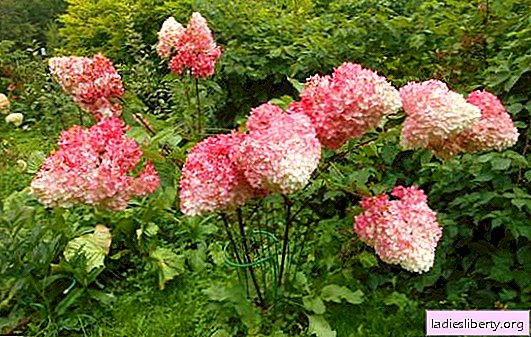
For gardeners of the temperate climatic zone, panicle hydrangea is a valuable plant.
Endurance and frost resistance combined with lush flowering make the Far Eastern beauty one of the favorites in the garden.
What to do to make the plant feel fine and delight the gaze of the owner?
Description of panicled hydrangea
For care to be effective, you need to know some of the features of the plant. Panicled Hydrangea (Hydrangea paniculata) is a fast-growing shrub-mesophyte from the Hydrangea family. Homeland is the Far East: China, Japan, Korea, southern Sakhalin. In the form of a tree grows up to 10 meters in height.
The root system is superficial, it does not lie particularly deep, the bulk of the roots is located approximately in the upper 30 centimeters of the soil. They grow significantly in breadth, often the border of the rhizome exceeds the diameter of the crown of the plant. The leaves are ovoid.
A distinctive feature is exceptional frost resistance (can withstand up to -25 ° C without shelter), as well as inflorescences.
Cone-shaped panicles up to 40 centimeters long, similar in shape to chestnut or lilac.
The color of the inflorescences may vary depending on the plant variety. Flowering begins at 4-5 years of life, from June to October. Honey plant, growing fast.

Growing conditions of panicled hydrangea
Sciogeliophyte, in nature the plant is found in the undergrowth, grows in the shade of higher trees. This means that in the garden hydrangea will prefer the appropriate place: not too bright and not shaded. It is a shade-tolerant plant, but will not grow, for example, in the shade of a house. At the same time, the decorativeness of flowers is quickly lost in the bright sun, which can also cause burns on the leaves.
Hydrangea is adapted to life in an environment with sufficient, but not excessive moisture, suitable for the middle zone, forest or forest-steppe zones, meadows. Weakly tolerated by prolonged drought. It feels great in neutral or slightly acidic (pH = 6.0-5.5) loose, but not too water-intensive soil.
Heavy and acidic soils are not suitable. It is necessary to distinguish panicle and tree hydrangeas. The second is more hardy and less whimsical to the ground. Responsive to fertilizing with mineral and organic fertilizers.

Planting panicle hydrangea
From the foregoing, it follows that hydrangea needs to be planted in a separate, separate, brightly lit scattered light, sheltered from the wind place. Here it will grow, dominate and attract attention.
It is necessary to abandon the neighborhood with bulbous flowers, since they require constant digging, which is fraught with a hydrangea root system. Plants covering the soil can be planted nearby.
When a place is chosen, you can dig a hole. It should be from 50 to 90 centimeters in diameter, depending on the size of the seedling, to a depth of 60 centimeters.

For young plants there will be enough depth on the bayonet of a shovel. The distance between several bushes should be about 2-3 meters.
The composition of the soil is suitable as follows: 1 part of the original soil, 1 part of humus, 1 part of acid peat. Instead of peat, they also take sawdust, preferably from coniferous trees or coniferous litter. You can very carefully add urea, superphosphate and potassium sulfate in a ratio of 1: 2: 1.
Hydrangea is a hygrophilous plant. And when planting in sandy, light soils or in the sun, expanded clay can be added as a water-retaining component.
At a young age (stem thickness of about 0.5 centimeters), hydrangea with soft bark calmly tolerates a small (5-10 centimeters) deepening and gives additional roots. If the plant is older and more massive, then it is better to plant it without deepening. Sagging by 3-5 centimeters is not critical. If the seedling has an open root system, then a mound should be made in the pit, put a plant on it and lower the roots along this mound, like a jellyfish. The roots themselves can be pruned a little to provoke their branching. Dry the slices or treat them with powdered charcoal. If the root is closed (from the pot), then the mound does not need to be done.

After planting, the soil should be compacted, water the plant. Effective use of root-forming agents and stimulants. Do not be shy, they will help hydrangeas take root without unnecessary stress.
As the plant grows, it is advisable to mulch the soil with acid peat, pine bark or humus.
Planting, of course, is better in the spring, at the end of March, in April, before the start of active vegetation. Possible landing in summer or autumn. In this case, the area around the plant should be mulched with acid peat or coniferous litter.
At the time of purchase, you should prefer not imported plants, but grown in your region or climatic zone. Choose 2-3 year old plants. Through the season, under favorable conditions, she will delight with her flowering.
Caring for panicle hydrangea
The plant has established itself as unpretentious. Watering should be timely and plentiful, under the root in the trunk circle. Feeding of rooted plants is carried out regularly during the growing season.
Both root and foliar top dressing are equally suitable. Alternate mineral and organic fertilizers. They stop feeding in August, so that hydrangea slows down and has time to bark new shoots before winter.
The delicate parts of the shoots are frozen over during the winter. As a prophylaxis at the end of summer, the use of a pink potassium permanganate solution is effective.
Afraid of stewing and moisture in September. Wood better ripens at this time in the dried conditions and winters better.
Trimming panicle hydrangea
In the spring dry frozen parts of shoots are removed. At the same time, several young and several shoots of different ages are left. Old ones are cut into two kidneys. In such conditions, hydrangea rejuvenates, grows magnificent and beautiful.

Pruning in the summer is carried out in order to form a bush. All shoots are shortened by three buds. Decorativeity is restored very soon, since hydrangea is growing rapidly.

If there is a preference to give the bush the shape of a standard tree, then all growing shoots are nipped according to the recommendations common to the standard.
Cutting in the autumn is enough just hats of flowers.

Pests and diseases of panicled hydrangea
With proper care, hydrangea does not get sick, and if this happens, it is very rare. The main problem is chlorosis, which occurs due to changes in the balance of trace elements in the soil. To avoid this, hydrangea should be regularly fed with complex fertilizers. Since with frequent watering, nutrients are washed out with water. Or use "long-playing" types of dressings in the form of sticks or granules. But this is not a panacea. Keep track of the plant and its reactions to your actions.
The main enemy of young, and adult plants, are snails, slugs and caterpillars. With the onset of heat, they most often attack fresh, young shoots and begin to eat them. You should fight with uninvited guests. For prevention, treat your plants with insecticides and fungicides.
In general, panicle hydrangea is an unpretentious and elegant plant. With proper care and proper fit, she will immediately reciprocate and will delight you with flowers that are wonderful in shape and color.











